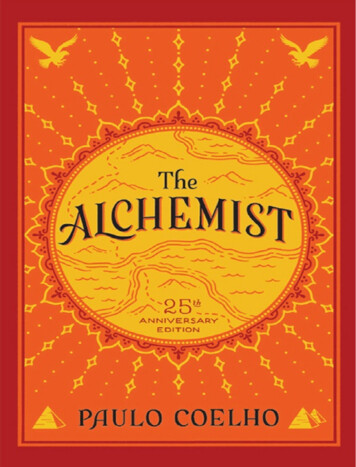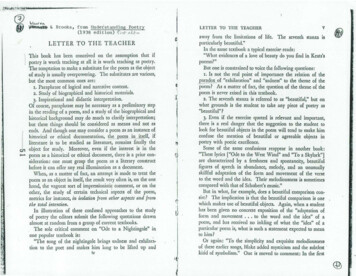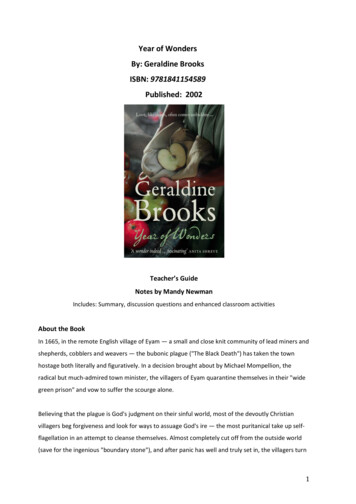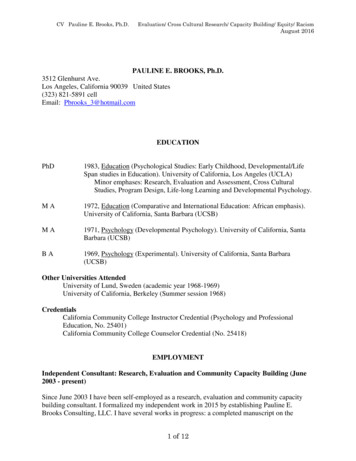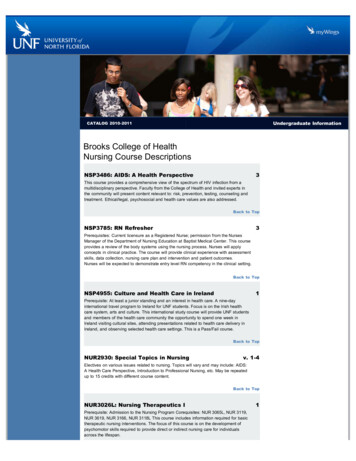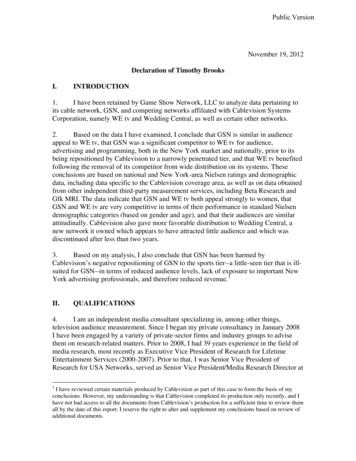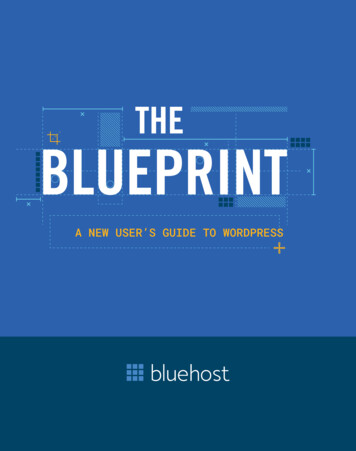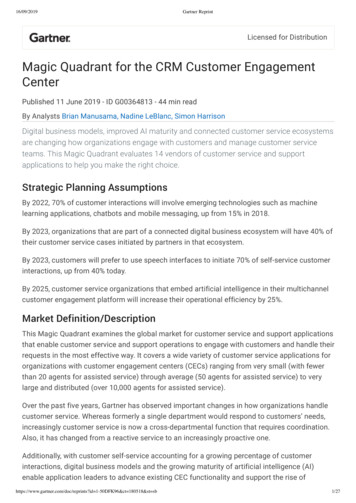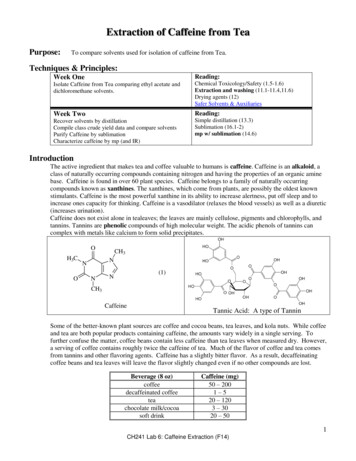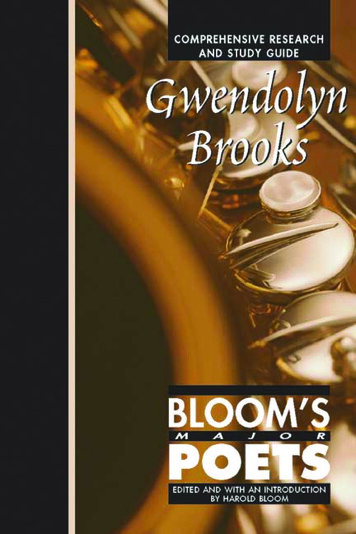
Transcription
GwendolynBrooks
C U R R E N T LY AVA I L A B L EBLOOM’S MAJORDRAMATISTSBLOOM’S MAJORNOVELISTSBLOOM’S MAJORPOETSBLOOM’S MAJORSHORT STORYWRITERSAeschylusAristophanesBertolt BrechtAnton ChekhovHenrik IbsenBen JohnsonChristopherMarloweArthur MillerEugene iesGeorge BernardShawNeil SimonOscar WildeTennesseeWilliamsAugust WilsonJane AustenThe BrontësWilla CatherStephen CraneCharles DickensWilliam FaulknerF. Scott FitzgeraldNathaniel HawthorneErnest HemingwayHenry JamesJames JoyceD. H. LawrenceToni MorrisonJohn SteinbeckStendhalLeo TolstoyMark TwainAlice WalkerEdith WhartonVirginia WoolfMaya AngelouElizabeth BishopWilliam BlakeGwendolyn BrooksRobert BrowningGeoffrey ChaucerSameul TaylorColeridgeDanteEmily DickinsonJohn DonneH.D.T. S. EliotRobert FrostSeamus HeaneyHomerLangston HughesJohn KeatsJohn MiltonSylvia PlathEdgar Allan PoePoets of World War IShakespeare’s Poems& SonnetsPercy ShelleyAlfred, LordTennysonWalt WhitmanWilliam Carlos WilliamsWilliam WordsworthWilliam Butler YeatsJorge Luis BorgesItalo CalvinoRaymond CarverAnton ChekhovJoseph ConradStephen CraneWilliam FaulknerF. Scott FitzgeraldNathaniel HawthorneErnest HemingwayO. HenryShirley JacksonHenry JamesJames JoyceFranz KafkaD.H. LawrenceJack LondonThomas MannHerman MelvilleFlannery O’ConnorEdgar Allan PoeKatherine Anne PorterJ. D. SalingerJohn SteinbeckMark TwainJohn UpdikeEudora Welty
GwendolynBrooks
2003 by Chelsea House Publishers, a subsidiary ofHaights Cross Communications.Introduction 2003 by Harold Bloom.All rights reserved. No part of this publication may be reproducedor transmitted in any form or by any means without the writtenpermission of the publisher.Printed and bound in the United States of America.First Printing135798642Library of Congress Cataloging-in-Publication DataGwendolyn Brooks / Harold Bloom, ed.p. cm. —(Bloom’s major poets)Includes bibliographical references and index.ISBN 0-7910-6815-31. Brooks, Gwendolyn, 1917—Criticism and interpretation. 2.Women and literature–United States—History—20th century. 3.African Americans in literature. I. Series.PS3503.R7244 Z66 2002811.54'—dc212002004480Chelsea House Publishers1974 Sproul Road, Suite 400Broomall, PA 19008-0914The Chelsea House World Wide Web address is http://www.chelseahouse.comContributing Editor: Robb ErskineLayout by EJB Publishing Services
CONTENTSUser’s Guide7About the Editor8Editor’s Note9Introduction10Biography of Gwendolyn Brooks12Critical Analysis of “The Mother”15Critical Views on “The Mother”17Beverly Guy-Sheftall on a “Bronzeville” Mother17D. H. Melhem on Emotions in the Poem18Toks Pearse on a Mother’s Responsibility19Kathryne V. Lindberg on Abortion in the Poem21B. J. Bolden on A Mother’s Memory23Critical Analysis of “The Bean Eaters”25Critical Views on “The Bean Eaters”28D. H. Melhem on Aging in The Bean Eaters28Maria K. Mootry on the Public Response to The Bean Eaters29Beverly Guy-Sheftall on Elderly Women in Brooks’s Poetry31Mort Rich on the Common Language in the Work34B. J. Bolden on Poverty in “The Bean Eaters”37Critical Analysis of “We Real Cool”40Critical Views on “We Real Cool”44Clenora F. Hudson on Racial Themes44Barbara B. Sims on the Subtext of the Poem47Patrick M.N. Stone on Voice and Meaning49Gary Smith on Reality vs. Romance in the Poem50Kathryne V. Lindberg on the “We” in “We Real Cool”52James D. Sullivan on the Visual Appeal of the Poem56
Critical Analysis of “Bronzeville Woman in a Red Hat”61Critical Views on “Bronzeville Woman in a Red Hat”64Beverly Guy-Sheftall on the Meaning of “Bronzeville Woman”64D. H. Melhem on Brooks’s Voice in the Poem67Richard Flynn on Children in Brooks’ Poetry68B. J. Bolden on Economic Deprivation in the Poem69Critical Analysis of “Riot”73Critical Views on “Riot”78William H. Hansell on Violence in the Second Part of “Riot” 78Norris B. Clark on Brooks’ Themes of Love in Her Later Works86D. H. Melhem on John Cabot in the Poem88Charles L. James on Brooks’ Transition from Her Earlier Poetry91Critical Analysis of “Queen of the Blues”94Critical Views on “Queen of the Blues”97Gary Smith on the Harlem Renaissance in the Poem97D. H. Melhem on the Queen’s Themes100Emma Waters Dawson on Black Women in Brooks’s Poetry102George E. Kent on the Realism of the Poem104B. J. Bolden on Mame’s Courage105Bill V. Mullen on the Strength of Mame in the Poem107Works by Gwendolyn Brooks111Works about Gwendolyn Brooks113Acknowledgements119Index of Themes and Ideas123
USER’S GUIDEThis volume is designed to present biographical, critical, and bibliographical information on the author and the author’s best-known ormost important short stories. Following Harold Bloom’s editor’snote and introduction is a concise biography of the author that discusses major life events and important literary accomplishments. Aplot summary of each story follows, tracing significant themes, patterns, and motifs in the work. An annotated list of characters supplies brief information on the main characters in each story. As withany study guide, it is recommended that the reader read the storybeforehand, and have a copy of the story being discussed availablefor quick reference.A selection of critical extracts, derived from previously publishedmaterial, follows each character list. In most cases, these extractsrepresent the best analysis available from a number of leading critics. Because these extracts are derived from previously publishedmaterial, they will include the original notations and referenceswhen available. Each extract is cited, and readers are encouraged tocheck the original publication as they continue their research. A bibliography of the author’s writings, a list of additional books and articles on the author and their work, and an index of themes and ideasconclude the volume.7
A B O U T T H E E D I TO RHarold Bloom is Sterling Professor of the Humanities at YaleUniversity and Henry W. and Albert A. Berg Professor of English atthe New York University Graduate School. He is the author of over20 books, and the editor of more than 30 anthologies of literary criticism.Professor Bloom’s works include Shelly’s Mythmaking (1959),The Visionary Company (1961), Blake’s Apocalypse (1963), Yeats(1970), A Map of Misreading (1975), Kabbalah and Criticism(1975), Agon: Toward a Theory of Revisionism (1982), TheAmerican Religion (1992), The Western Canon (1994), and Omensof Millennium: The Gnosis of Angels, Dreams, and Resurrection(1996). The Anxiety of Influence (1973) sets forth Professor Bloom’sprovocative theory of the literary relationships between the greatwriters and their predecessors. His most recent books includeShakespeare: The Invention of the Human, a 1998 National BookAward finalist, How to Read and Why (2000), and Stories and Poemsfor Extremely Intelligent Children of All Ages (2001).Professor Bloom earned his Ph.D. from Yale University in 1955and has served on the Yale faculty since then. He is a 1985MacArthur Foundation Award recipient and served as the CharlesEliot Norton Professor of Poetry at Harvard University in 1987–88.In 1999 he was awarded the prestigious American Academy of Artsand Letters Gold Medal for Criticism. Professor Bloom is the editor of several other Chelsea House series in literary criticism, including BLOOM’S MAJOR SHORT STORY WRITERS, BLOOM’S MAJORNOVELISTS, BLOOM’S MAJOR DRAMATISTS, MODERN CRITICALINTERPRETATIONS, MODERN CRITICAL VIEWS, and BLOOM’SBIOCRITIQUES.8
EDITOR’S NOTEMy Introduction centers upon the controlled pathos of “TheMother.”Kathryne V. Lindberg, commenting on “The Mother,” commendsBrooks for “at once humanizing and equivocating over victim andagent,” while Maria K. Mootry notes the oblique effectiveness of“The Bean Eaters.”“We Real Cool” moves Gary Smith to contrast urban reality toromance in the poem, after which, D. H. Melhem analyzes Brooks’svoice in “Bronzeville Women in a Red Hat.”“The Riot” is viewed by Charles L. James as marking a new modein Brooks, while “Queen of the Blues” is illuminated by Gary Smithand George E. Kent, among others.9
I N T RO D U C T I O NHarold BloomGwendolyn Brooks (1917-2000) lived a long and distinguishedlife, marked by her continuous devotion to writing the poetry of herpeople. Her early poem, “The Mother,” remains an impressive dramatic monologue, restrained alike in its pathos and its irony, andcuriously wrought in emotional contraries:Abortions will not let you forget.You remember the children you got that you did not get,The damp small pulps with a little or with no hair,The singers and workers that never handled the air.You will never neglect or beatThem, or silence or buy with a sweet.You will never wind up the sucking-thumbOr scuttle off ghosts that come.You will never leave them, controlling your luscious sigh,Return for a snack of them, with gobbling mother-eye.It is difficult to describe the effective balance of this chant. Whatprecisely is the speaker’s attitude towards her unborn children?Handling the air is very different for “singers and workers,” and theimagery of “luscious,” “snack,” and “gobbling” turns upon animplicit critique of the speaker’s narcissism, while still expressingher implicit loss.It is the second verse-paragraph that achieves a more disturbinglevel of intensity, in which something like a lament rises (thoughvery obliquely) for those never allowed to be:You were born, you had body, you died.It is just that you never giggled or planned or cried.A dispassionate lament is an irony, and so is the poem’s conclusion:Believe me, I loved you all.Believe me, I knew you, though faintly, and I loved, I lovedyou all.10
Brooks later became a poet of social protest, joining in the principal currents of African-American poetry in the last third of thetwentieth century. She became more direct, and doubtless a liberating force. The enigmas of her earlier poems, like “The Mother,” tome seem imaginatively richer.11
BIOGRAPHY OFGwendolyn BrooksOn June 7, 1917 Gwendolyn Brooks was the first of two childrenborn to David Anderson Brooks and Keziah Corinne (Wims)Brooks. Born at her grandmother’s house in Topeka, Kansas;approximately one month after her birth she was taken back to herparents’ home in Chicago where she lived for the rest of her life.Gwendolyn’s passion for writing and interest in poetry began atan early age and by the age of thirteen she published her first poemin the magazine American Childhood. During her years in highschool, she met the poet James Weldon Johnson who encouraged herto read and emulate poets like T.S. Eliot and e.e. cummings. Thischance meeting was inspirational for Brooks and by the age of sixteen she had published over seventy poems. Her notoriety was further fueled by her association with Langston Hughes who encouraged her to continue reading and writing and often wrote aboutGwendolyn’s promise and talent in his newspaper column.In 1935 Brooks graduated from Englewood High School andwent to Wilson Junior College to study English. After graduating in1936, Brooks unsuccessfully tried to obtain a full-time writing position at the Chicago Defender, where she had been a weekly contributor to the column “Lights and Shadows,” but she was turned away.She worked as a maid in a few homes and then later as a secretary inseveral offices before she got a job working as a publicity directorfor the Chicago chapter of the National Association for theAdvancement of Colored People (NAACP) youth council.On September 17, 1939 she married Henry Blakely and over thenext few years they both began attending Inez Cunningham Starks’poetry workshops where Starks furthered Brooks’s knowledge ofcontemporary poets and introduced Brooks to the bubbling poeticscene in Chicago. The workshop discussions were open and honestand at times a bit brutal. During this time Starks and others critiquedBrooks’s work thoroughly. Brooks grew from this experience and in1943 she won a poetry award from the Midwestern Writer’sConference. Two years later her first collection of poetry A Street inBronzeville (1945) was published through Harper & Row.12
This first collection mirrored her own experiences in the suburbof Chicago called Bronzeville. The collection is broken into two distinct sections with the first detailing the average, day-to-day occurrences of people Brooks knew in Bronzeville. The poetry is markedby Brooks’s combination of its simple language and direct sentenceswith a strict adherence to poetic metre and structure including a fewsonnets. The second part of the collection details the unfair treatmentof African Americans in the military during WWII. The collectionwas met with praise and shortly after it was published she wasawarded a Guggenheim fellowship. This notoriety was furtheredwhen she became the first African American to win the PulitzerPrize for her second collection, Annie Allen (1949).In 1953 Brooks demonstrated her versatility with the novel MaudMartha. This autobiographical novel explored the racist, sexist, andother oppressive forces surrounding an African American womanbefore, during, and after WWII. Her fourth publication, The BeanEaters (1960), reflected Brooks’s growing interest in civil rightsissues and marks the beginning of her experimentation with freeverse. During the period between publications Brooks taught creative writing at several universities, including Columbia College(Chicago), Northeastern Illinois University, Elmhurst College,Columbia University, Clay College of New York, and the Universityof Wisconsin.Her poetic style and interest in Black Studies was foreverchanged after attending the Second Black Writers’ Conference atFisk University. At this conference she met Amiri Baraka (formerlyLeRoi Jones), Ron Milner, and Haki R. Madhubuti (formerly Don L.Lee). Their work and conviction for civil rights and black culturalnationalism inspired her, and her next work In the Mecca (1968)reflected this spiritual change. Mo
It is a monologue and a lament of one woman which ulti- mately transcends the worries of one person and becomes the agony of a community, even of humanity. 20 A murder has been committed, a child is killed, human blood has been spilled and leaves a trail of guilt “abortions will not let you for- get.”.File Size: 1MBPage Count: 126
